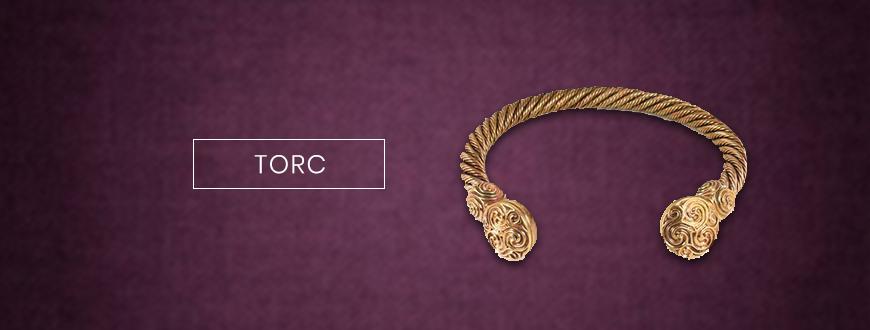Kalyan Wiki

Torc
Torc or torque is a rigid ornament worn on the wrist or the neck. The word 'torc' is derived from the Latin word 'torquis' which means 'to twist'. It is made from a single hard metal or a string of twisted metal. Most of them have an opening at the front, but there are also ones with hook and ring or locking catches. Fashion lovers wear this ancient ornament as statement jewellery to get a bold plus stylish look.
History of Torc
It is an ornament that dates back to the bronze age(old European). Most of the torc remains found from there are twisted ribbon-like ones made of gold. Even though the remains of this jewellery are found along with the remains of the Vikings and ancient Iran civilization, the Celts were the masters in this jewellery craft. An example of this is the Broighter Collar. It is linked to the La Tène culture, but it is similar to a Celtic design as per some historians' opinions. You can find these infamous history museums like the British history museum.
It was more of a permanent ornament, which means that most of the Celtic natives were supposed to wear this from early childhood to adulthood.
Torc in Modern Fashion
Other than just plain metal or thin strings of twisted metal, we see them being replaced by shiny materials that have a "bling" look to it. Here are some of the torc jewellery in fashion today:
- Torque bangles or bracelets with gorgeous crystals or precious stones.
- Torque necklaces or rings made from shining silver-simple but elegant.
- Viking civilization inspired rough and unpolished oxidized metal made neck and wrist wear.
- Torc made in hard metal with designs of ancient scripts, animals or flowers inscribed in it.
We need highly skilled artisans to craft this unique adornment, who can handcraft each piece with the utmost care.
How to Wear a Torc?
The main issue with wearing a torc is breaking off the front ends, especially prominent ones with open ends. When you continuously bend metal at one of the ends to wear it, the metal begins to harden, and as time passes, it becomes more brittle, which leads to breakage. The only way you can avoid cracking is to stop moving it back and forth while wearing. Be careful and slowly add some friction into it while wearing the torc. This method will help you wear your favourite torc jewellery without the fear of breaking it.







